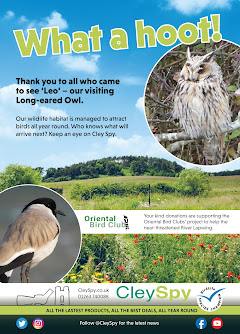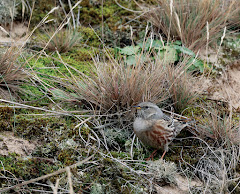26th August 2011.
"AT this time of the year we always see a small robin-sized bird craftily hopping about our garden.
Its legs are longish and its beak is sharp, while its breast is speckled. It is in fact a juvenile robin, not having acquired its red breast, which will gradually appear as the bird begins its first moult.
This phase of its plumage often excites comments from novice garden owners who may question the identity of this strange bird, whose mannerisms nonetheless are very much those of an adult robin.
Another creature that sometimes causes great interest is a large caterpillar, which can be seen leaving its food plants of willow herbs and/or plants of willow herbs or fuschia from which it often crawls for a considerable distance, trying to find a suitable patch of earth in order to construct a flimsy cocoon on or near the ground surface in which it will pass the winter months.
If encountered it arouses great interest because of its large size and life-like eye markings near the front end of its long trunk-like head (hence its name: “elephant hawk moth”). The adult moth flies from May to July but it is not seen so often as its larva. If seen at dusk it may be visiting the tubular flowers of honeysuckle. Its pink and olive green forewing and pink and black hindwing are unmistakable.
Our buddleia bushes have given a most splendid show of blooms in pink, blue and yellow, but where, oh where, are the butterflies?
Red admirals have ever been present since early summer and these have been boosted by a few cabbage whites, up to a dozen gatekeepers, six meadow browns, three to five commas, but never more than three peacocks and two small tortoiseshells.
Holly blues and speckled woods have commonly frequented shadier areas of our woodland type garden, while up to the present time we have recorded humming bird hawk moths almost daily since early July.
Interestingly the often maligned globosa buddleia, although flowering too early for most butterflies, was alive with bumble and flower bees during its entire flowering period from late May to late June.
Why are the usual visitors to our buddleias so scarce? It was not unusual to see scores of peacocks and small tortoiseshells taking nectar. Was it the very hard winter followed by a dry spring? We hope it is only locally scarce.
I have heard that good numbers of chalk-hill blue butterflies have been introduced to a grassy Norfolk hill. According to Richard South’s “The Butterflies of the British Isles” first published in 1906, only one small isolated colony of this species could be found in Norfolk. Elsewhere, it was more commonly found on the downs of southern England and at a few places in north Suffolk close to the Norfolk border.
Some 60 years ago I heard from an old entomologist that the Norfolk colony was at Ringstead Downs. One day I made the long cycle ride from Sheringham to see this beautiful butterfly flying on the grassy slopes. I obtained several photographs. Sadly this colony became extinct at about the time of the first myxomatosis outbreak in rabbits. It is thought that the lack of grazing contributed to the extinction of the chalk-hill blue.
PETER CLARKE








































Ringstead Downs are an isolated site. There are no nearby sites where chalkhill blues could be found and help maintain a genetically diverse population not dependent on one location.
ReplyDeleteChalkhill blues were introduced at Warham Camp in the past. That colony became extinct perhaps through inbreeding of the small population.
I was unaware of the current Chalk-hill population at Warham until last week (28/08/21)when I came across the camp helped with directions from our BnB host who was bought up in Wells and suggested off the cuff that it might be an interesting place to visit.Notably this is 10 years after the comment above when they appear to be thriving again. Thanks for maintaining this blog, always a good read when I drop on it. Regards Mick
ReplyDelete